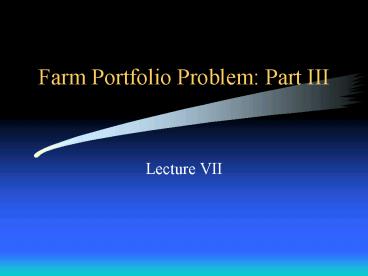Farm Portfolio Problem: Part III PowerPoint PPT Presentation
1 / 24
Title: Farm Portfolio Problem: Part III
1
Farm Portfolio Problem Part III
- Lecture VII
2
Target MOTAD
- The target MOTAD model is a two-attribute risk
and return model. - Return is measured as the sum of the expected
return of each activity multiplied by the
activity level. - Risk is measured as the expected sum of the
negative deviations of the solution results from
a target-return level. - Risk is then varied parametrically so that a
risk-return frontier can be traced out.
3
- Mathematically, the model is stated as
4
Discrete Sequential Stochastic Programming
- Target MOTAD, direct expected utility, and even
MOTAD begin to develop the concept of constraints
being stochastic or met with some level of
probability. - In target MOTAD, income under a certain state
exceeds the target level of income with some
probability.
5
- In direct expected utility maximization the level
of wealth transferred to the objective function
was represented by a constraint which had some
level of probability. - In MOTAD, we minimized the expected negative
deviations which implied stochastic constraints.
6
- However, in each of these cases, the primary
impact of stochastic constraints was on the
objective function or some threshold level of
risk (as was the case in target MOTAD).
7
- The variant of model that we want to develop is
referred to as Discrete Sequential Stochastic
Programming (DSSP), although other names have
been attributed to it. This work grows out of
work by Cocks, and focuses on decision processes
which are strung out over a discrete number of
decision periods.
8
Action 1
Outcome 1
Payoff 1
P1
Action
Event
Action 2
Outcome 2
P2
Payoff 2
9
- At a discrete point in the future, the farmer has
to make a decision, for example a stocking rate
on cattle. Given this first round decision and a
random outcome, such as rainfall, there is then a
subsequent decision to be made, for example
whether to sell cattle or buy feed. - Each state occurs with a given level of
probability and each node can contribute to the
objective function.
10
- A mathematical formulation
11
- In this model x1 represents the acres of wheat
planted, x2 is the number of stockers purchased,
x3 the tons purchased under outcome 1, and x4 the
tons of feed under outcome 2. - The first two equations, then, simply balance the
feed requirements under each state of nature.
For example, if there is good rainfall in state
1, then more grazing will be produced by the
wheat ,x2, and less feed will have to be
purchased than in state 2. C1 and c2 are then
the cost of feed in each state weighted by the
probability of that state.
12
- The third equation then transfers the cattle
purchased into the next decision period. X5 is a
variable modeling the number of stockers sold,
while x6 models any additional stockers
purchased. The total number of stockers in the
next production period is x7. Given the number
of cattle transferred into the next period the
feed balance relationships determine the level of
feed that must be purchased.
13
- Chance Constrained Programming.
- The DSSP problem above assumes that the possible
outcomes can be represented in a finite number of
states, although several pieces of applied
research have examined the efficiency of
approximating the moments of a continuous
distribution with a finite number of points.
14
- An alternative would be to constrain the
probability. For example, assume that you want
to constrain the probability that profit will be
less than a fixed level T (to borrow the target
MOTAD concept). Mathematically, this constraint
becomes
15
- Under normality, we can transform this constraint
via the confidence interval
16
Generalized Mean-Variance
- A Reformulation of the EV Problem
- The typical mean-variance crop selection model is
expressed as
17
- An extension of this model involves appending a
term on the constraints which accounts for risk
in the constraints. Specifically, rephrasing the
profit function as
18
(No Transcript)
19
- This specification gives rise to a related pair
of mathematical programming models. - The primal
20
- The dual
21
- This specification is consistent with chance
constrained programming. Specifically,
maximizing the primal above can be viewed as
maximizing the certainty equivalent of a risky
revenue subject to the constraint that the
probability of the marginal value of the
constraints is less than a given critical level
with some probability. Mathematically,
22
- Portions of the relationship between the chance
constrained probolem and the generalized
mean-variance programming formulation are
dependent on the Kuhn-Tucker conditions.
23
(No Transcript)
24
(No Transcript)

